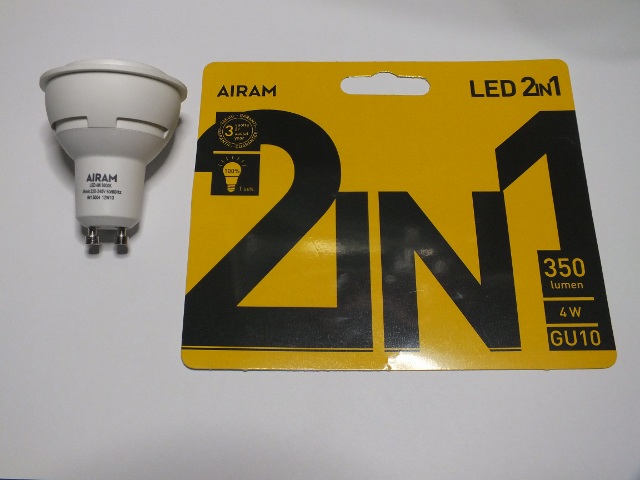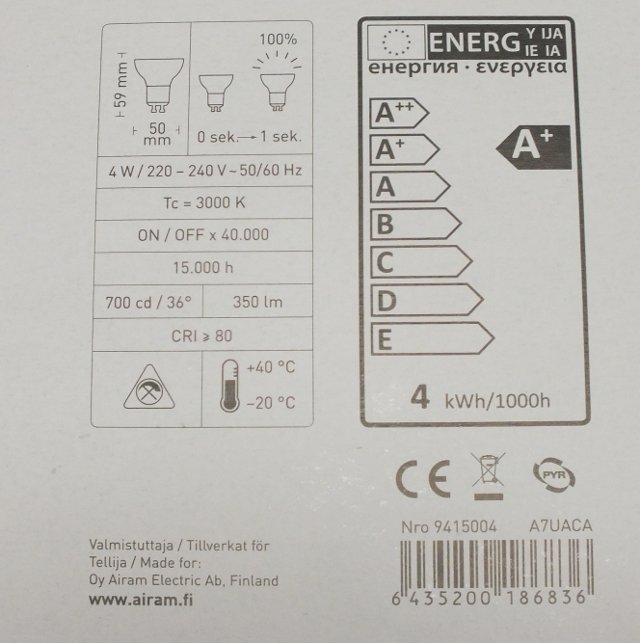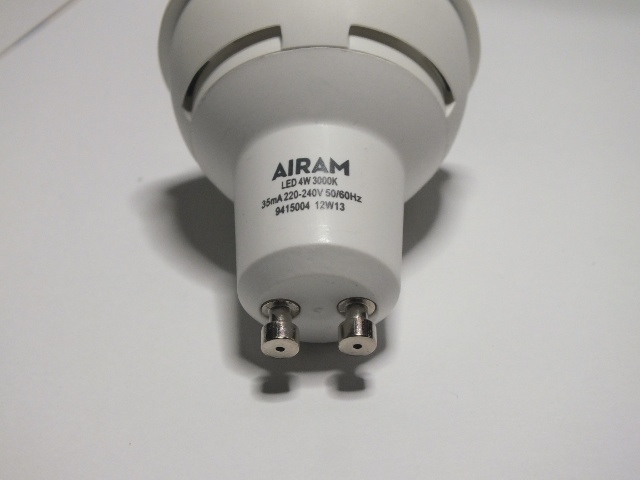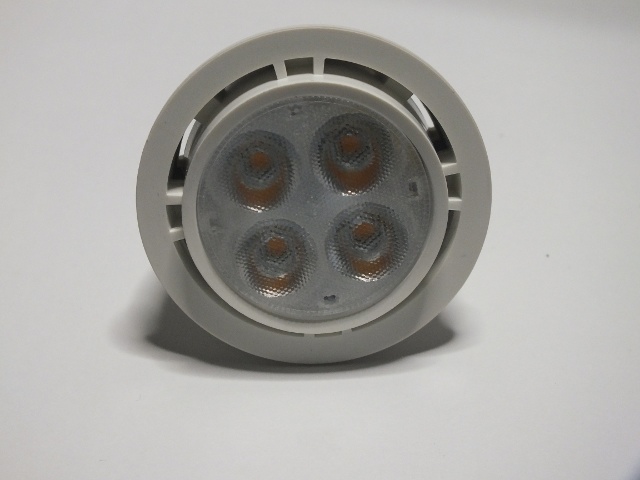I needed to replace few burned 50W GU10 halogen bulbs with LEDs. A standard 50W halogen lamp outputs 400 lumens so I needed to find a reasonably LED bulb that gives around the same light output. I could live with slightly less, but not too much less.
I found suitable looking product AIRAM LED 4W GU10 350LM 2KPL 43-8924 from local Motonet shop. The 9,90 Euro package contains two LED lamps, so one bulb will end up costing slightly less than 5 Euros. That’s very reasonable price for brand with some reputation. Airam is a Finnish company and I have heard good comments on their LED product earlier.
AIRAM LED 4W GU10 350LM 2KPL 43-8924 specifications are 4W power, 350 lumen light output, GU10 base, 3000K color temperature and 15000h lifetime. All those specifications looked suitable for me, so I bought the bulbs and brought them to home.
Here are some pictures on the material in the package:
Here is close-up of the bulb details. The bulb case seems to be made of white plastic and aluminum heat sink painted white.
There are four 1W white LEDs in the bulb:
I installed the bulbs to use. Lumen output according to technical data is a little bit lower than 50W halogen (350 lumen vs 400) but the light felt as bright or even brighter than halogens: tighter beam focused where light is needed and different light temperature can affect.
I did some measurements with light meter to see the performance. The average light level on the room was around the same as it it was before. The light distribution was somewhat different, and when I turned to bulbs more towards my working table I got nice light there.
I did some crude measurements on the light beam brightness. First I compared the light output in from of the bulb: LED bulb was around 1.5 times brighter than 50W halogen when measured direct in front (1 meter distance). When going more to side it became less bright than halogen. -> tighter beam than the original bulb. Tighter beam was good in my application, more light where I wanted it.
The LED bulb package did not tell anything if this could be dimmed. I did a quick testing. I could not get the bulb to dim well with normal light dimmer (trailing edge), the light started to flicker when I had just the LED connected to dimmer. I also tried configuration where I had 40W normal bulb in parallel with the LED bulb (to make the dimmer work better), but it did not seem to help. So it seems that this LED bulb is not designed to be dimmed with at least that dimmer.
To get more information I also tested dimming with reverse phase (leading edge) type dimmer I had built. In this test I found that the LED bulb dimmed with it nicely. Reverse phase type dimmer usually works best on LED bulbs, and it was the case also with this bulb. Reverse phase control works best with capacitive loads, which means most LED bulbs.
I was happy with AIRAM LED 4W GU10 350LM 2KPL 43-8924. They did well what they promised.




32 Comments
Tomi Engdahl says:
Build A 100W LED Flashlight
http://hackaday.com/2015/05/21/build-a-100w-led-flashlight/
In case you’re not aware, you can hop on your favorite online Chinese electronics retailer and buy a hundred Watt LED module for less than $10 USD. That’s an enormous amount of retina-burning fun, but how do you turn it into a flashlight? DIY Perks shows you how.
Make a 1000w equiv. LED flashlight – aka DIY Sun-Blaster!
https://www.youtube.com/watch?v=c–5c3Egv4E
Tomi Engdahl says:
Teste Lanterna LED 100W 9000LM VS 3X XML-T6 3800LM.
https://www.youtube.com/watch?v=KMG05X21rKc
Tomi Engdahl says:
Ebay LED floodlight scam warning.
https://www.youtube.com/watch?v=vbt2ojkXPuo
If you’ve bought or are considering buying an LED floodlight from ebay, then this video will show you some of the pitfalls. From unconnected ground wires to MUCH less than half the quoted power rating.
It’s a shame really, because otherwise these fixtures are very neat and functional.
Tomi Engdahl says:
The LED: incandescent light bulb heir apparent
http://www.edn.com/electronics-blogs/brians-brain/4441540/The-LED–incandescent-light-bulb-heir-apparent?_mc=NL_EDN_EDT_EDN_today_20160317&cid=NL_EDN_EDT_EDN_today_20160317&elqTrackId=5a174424ea3947dbb7263dbf3b0ddc70&elq=926b7c1d3720474d91005dc17a2bfbe4&elqaid=31375&elqat=1&elqCampaignId=27425
Much ink (cyber and physical alike) has been published over the years, both in EDN and elsewhere, regarding the relative merits and shortcomings of various supposed successors to the venerable incandescent light bulb. CFLs (compact fluorescent light bulbs) were initially seen by the “green” crowd (which, to be clear, counts yours truly among its members) as the most likely candidate, thanks to their touted higher efficiency and longer lifetime versus incandescent precursors. But they haven’t particularly panned out, in my opinion. I’d like to propose some reasons why, in the form of a list that took me only a few minutes to brainstorm (and therefore may be incomplete; sound off in the comments with suggested additions).
Initial expense: CFLs are admittedly much less pricey than they initially were, thanks both to volume manufacturing cost efficiencies and government legislation-induced forced phase-outs of incandescent alternatives. But they’re still fairly expensive;
Size and appearance: Even if a CFL could screw into and work in an incandescent-intended socket (not an ironclad guarantee, given various dimensional variances), the CFL might not fit in the enclosure, given length and width incompatibilities versus the incandescent bulb predecessor. And even if it physically fits, let’s be honest, CFLs’ twisted appearance is comparatively unattractive; a non-issue when obscured by a shade, perhaps, but otherwise an aesthetic barrier.
Temperature-induced reliability issues: While a CFL may throw off less heat than an incandescent, its base contains circuitry absent from an incandescent … circuitry that’s heat-sensitive.
More general quality and reliability concerns: Numerous case studies I’ve repeatedly seen over the years suggest that low-priced CFLs in particular are (much) less-than-perfect
Dimming and flickering, and eventual tube failure
Color temperature variance:
Ballast buzz and premises power grid effects: Consumers are also familiar with the annoying buzzing noise emitted by a conventional fluorescent light’s ballast, a din that also plagues low-quality CFLs in particular.
Dimmer switch incompatibilities: Incandescents are inherently dimmer switch compatible. The same can’t be said for CFLs; in fact, using a conventional CFL with a dimmer switch can result in a fire (and at minimum, severely degraded switch and/or CFL operating life)!
Slow-to-no turn-on
Form factor
Mercury: Ideally (although many consumers likely shrug this off, if they even know about it at all) used-up CFLs should be disposed of at an official recycling center, so that the mercury they contain can be responsibly dealt with.
Tomi Engdahl says:
That 60W-equivalent LED: What you don’t know, and what no one will tell you…
http://www.edn.com/electronics-blogs/led-insights/4423570/That-60W-equivalent-LED–What-you-don-t-know–and-what-no-one-will-tell-you-?_mc=NL_EDN_EDT_EDN_review_20160610&cid=NL_EDN_EDT_EDN_review_20160610&elqTrackId=42109277f16440eba2a5857a324a5d04&elq=6b18a09b74cb468aab5886a00fd20043&elqaid=32631&elqat=1&elqCampaignId=28496
Most readers are aware of all the recent hoopla regarding 40- and 60-watt LED versions of standard 40- and 60-watt bulbs. Prices have dropped sharply, appearances have become somewhat standardized and dimmable versions are becoming commonplace.
we will have such bulbs with built-in Wi-Fi, color tuning, smartphone gadgetry, retail pricing
Perhaps time for a reality check or two… meaningful for the average consumer, who has no little or no clue about CCT, CRI, or heat sinking as they buy light bulbs to simply put light when and where it’s needed
First some facts: For decades consumers have come to assume (a reasonably valid assumption) they can buy almost any CFL and screw it into any place they previously had a 40W or 60 W incandescent bulb. Maybe it would not allow dimming…maybe it was slow to warm up… maybe the color consistency was not as expected…
It follows then that consumers now have a similar expectation for LED versions, with even longer life and greater electricity savings, dimming, and even better color consistency.
Let’s shift gears a second. Probably 95% of all UL approved recessed down-light fixtures have, for decades, incorporated simple inexpensive “thermal cutouts”.
Back to our story: Turns out that the consumer’s assumption is not valid: that the LED bulb is just another upgrade like the CFL. As noted, folks assumed that anywhere you had the 40W or 60W incandescent, you could screw in the CFL.
Within an LED bulb the internal generation and distribution of heat is such that it “desperately” needs access to cool surrounding air.
That 60 watt Wal-Mart bulb, when operating base down in open air and not even using a shade, has its internal LED case at 85°C, the absolute upper end of what is considered “safe” for full life expectancy. The same deal is true for competitive bulbs.
reliability and life expectancy go down hill sharply as soon as you install it anywhere that air is restricted.
LED bulb recalls in last two years stemming from thermal design carelessness
Tomi Engdahl says:
LED lamps quality has improved
Recent European studies have shown that the characteristics and quality of LEDs have evolved faster than expected. At the same time their prices have come down.
” The positive development of LEDs, in particular the fact that the lamps for energy efficiency has been further improved and prices have fallen significantly”
Often short service life of LEDs is due to the poor heat resistance. Enclosed luminaires heat does not evaporate, the operating temperature rises and the lamp breaks prematurely.
Source: http://www.uusiteknologia.fi/2016/06/16/ledilamppujen-laatu-parantunut-2/
Tomi Engdahl says:
Philips turbocharges the LED bulb, claiming huge efficiency breakthrough with Dubai
http://www.ledsmagazine.com/articles/2016/10/philips-turbocharges-the-led-bulb-claiming-huge-efficiency-breakthrough-with-dubai.html?cmpid=EnlLEDsOctober122016&eid=289644432&bid=1555051
The Dutch giant says that it and the UAE city have leaped way ahead to 200 lumens per watt, available this year.
The new Philips Dubai Lamp delivers 200 lm/W, making it the first commercially available lamp to break the 200-lm/W barrier, Philips said.
In the leapfrogging world of efficiency claims, it would appear to spring Philips way ahead of other vendors. It is difficult to pinpoint leaders, but some of the previous best lm/W claims from manufacturers for commercially available lamps have topped out in the 110–120 lm/W range. Philips’ own previous best was 101 lm/W. The new Dubai line doubles that.
Philips and Dubai developed the LED bulb under the patronage of Sheikh Mohammed bin Rashid Al Maktoum (right), Prime Minister of the UAE and Ruler of Dubai.
Philips and Dubai plan to begin distributing several different models later this year, rated at notably low wattage ratings of 1W as a 25W incandescent candle replacement with an E14 fitting, 2W as a 40W standard incandescent E27 replacement, and 3W as a 60W incandescent E27 replacement. The partners also introduced a 3W spot LED, rated at 133 lm/W — not 200 lm/W — to replace 50W halogen spots.
Tomi Engdahl says:
Incandescent lamps and service life
http://www.edn.com/electronics-blogs/living-analog/4442835/Incandescent-lamps-and-service-life-?_mc=NL_EDN_EDT_EDN_analog_20161013&cid=NL_EDN_EDT_EDN_analog_20161013&elqTrackId=fab6883de48f46ac9f0475def5d90d5c&elq=e6da369fa97a46adb1403c439367b791&elqaid=34336&elqat=1&elqCampaignId=29958
Yes, incandescent lamps are still with us. A lamp’s service life can be extremely brief or it can extend for many hours, days, months, years, or even decades.
Theatrical lamps for example are run at great stress to get as much light out of them as possible and as a result, they may only last for perhaps a few hours. However, at the other extreme, please see this link about the Centennial Light, which is a carbon filament lamp that has been operating almost without interruption since 1901.
The world’s longest-lasting light bulb is maintained by the Livermore-Pleasanton Fire Department in California.
Any prediction about operational lifetime is an approximation at best based on some “average” lamp being operated from an AC line. Lamp manufacturers can’t guarantee a minimum number of operating hours because each individual lamp’s lifetime is dependent on so many factors that lie outside of manufacturing control.
The brightness and current consumption properties of higher voltage lamps tend to be less dependable than those of lower voltage lamps and they tend to exhibit less predictable lifetimes. Also, higher voltage lamps are generally more vulnerable to shock and vibration troubles.
Because higher voltage lamps tend to be more fragile and more prone to failure, a higher voltage lamp should usually be avoided where a lower voltage lamp can serve. Lower voltage lamps tend to offer higher reliability.
In general though, for the longest lamp life, AC operation is preferred.
Please do take note that inrush current surges at turn-on can be a very destructive effect.
Those lamps would be slowly raised to full brightness and power and then, after clicking the camera shutter, slowly lowered back to zero again using a variable autotransformer also known as a Variac. By treating his lamps that way, he minimized lamp inrush currents to the greatest degree he could and avoided thermally shocking them as well.
Tomi Engdahl says:
Do not buy this kind of LED lamps:
Deadly LED lamps from China on ebay.
https://www.youtube.com/watch?v=08W2VIwBkhI
Just a couple of the wide range of LED lamps openly sold on ebay that have deliberately exposed solder connections directly referenced to the mains supply. Both lamps in this video have the potential to cause a serious electric shock.
Tomi Engdahl says:
Good vs. Bad LED Bulbs: Testing Current
https://www.youtube.com/watch?v=iE4ZjQcsSKY
Tomi Engdahl says:
Extra long LED filament lamp teardown
https://www.youtube.com/watch?v=NffhdAz9pc4
Another new twist with LED filaments. This style is designed to emulate traditional retro filament lamps with a very long LED filament that emits a very golden light.
Tomi Engdahl says:
Welcome to Light Bulb Selection Hell
http://www.electronicdesign.com/power/welcome-light-bulb-selection-hell?code=UM_NN7TT3&utm_rid=CPG05000002750211&utm_campaign=12213&utm_medium=email&elq2=49c083757ae4409d9d7ebabf70a084d5
Anyone can still change a light bulb without too much trouble, but buying one has become an altogether different matter.
How many engineers does it take to change a light bulb? The answer is “one,” but maybe the question should be changed to: How many engineers does it take to choose a replacement light bulb? Today, it actually requires an engineer’s knowledge.
It used to be easy to buy a light bulb. You simply noted the wattage of the defective bulb and bought a replacement from the minimal choices available (e.g., frosted vs. clear). Not so today. Most of the popular old incandescent bulbs have been banned and phased out over the years by way of a government mandate to save energy. Standard 40, 60, 75, and 100 W bulbs are no longer available other than via any lingering inventory.
To replace a bulb today requires that you buy a compact fluorescent (CFL) or an LED of equivalent brightness. They cost more, but last longer and use much less energy. So it is a positive thing overall. What makes things so difficult is that there are so many replacement choices. And instead of just a wattage rating, you need to pay attention to the lumens (brightness) rating and color specification.
I needed: a 65 W incandescent flood for a recessed ceiling light and a standard three-way 250 W bulb for my reading lamp. They still sell these. The equivalent LED flood was way too pricey, so I stayed with the incandescent. As for the 250 W bulb, I know that it’s wasteful—but also bright. I like bright, and replacement CFLs and LEDs just don’t do it for me.
A few years back I did replace most of the lamp, ceiling fixture and outdoor bulbs with CFLs. They’re certainly bright enough, and I felt good that I was saving energy. However, I never did see what I would call a real savings on my electric utility bill. Then I found out why: According to government statistics and studies, lighting represents only 9 to 14% of a typical household’s electric budget.
In case you didn’t know, most of the energy consumed in the home goes to air conditioning, heating, water heaters, refrigerators, and other major appliances.
So today, LEDs are the focus. Thanks to technological developments, their prices have come down significantly, making them a practical choice. You will benefit from the lower prices, brighter light, and energy savings. Just know that you’ll have hundreds of versions to choose from, including colors and Wi-Fi dimming via smartphone app.
Tomi Engdahl says:
Single-die LED delivers 1700 lumens
http://www.edn.com/electronics-products/other/4458690/Single-die-LED-delivers-1700-lumens
Housed in a chip-scale package, Lumileds’ Luxeon V LED produces more than 1700 lumens at 5700K and 70 CRI (color rendering index) at 4.8 A—50% higher output than competing LEDs, according to the manufacturer. The device’s patterned sapphire substrate CSP is just 4×4 mm and enables high efficacy at high drive currents, as well as high lumens/mm2.
Luxeon V has a nominal drive current of 1.4 A, but can be driven at up to 4.8 A, one of the highest drive currents in the industry.
Luxeon V LEDs offer a choice of CCTs (correlated color temperatures) ranging from 3000K to 6500K and operate over a temperature range of -40°C to +130°C at 1.4 mA.
http://www.lumileds.com/products/high-power-leds/luxeon-v
Tomi Engdahl says:
How to Replace / Convert a Halogen Floodlight with an LED Chip
https://www.youtube.com/watch?v=STNHmvcoD90
Tomi Engdahl says:
Mains Voltage LED (and how NOT to handle mains voltage!)
https://www.youtube.com/watch?v=PklaByEQSZA
Testing a mains voltage LED from China. This one is rated 220V and 20W. It really can be connected directly to AC mains with no LED driver. 30W and 50W versions are also available. In the listings it’s called “smart IC” or “integrated driver” or “driverless” COB LED.
Tomi Engdahl says:
12V LED Lamp teardown – schematic & how does a constant current driver work
https://www.youtube.com/watch?v=i-Roc5TLdnw
In this video I make a teardown of a 5W 12V~ LED lamp (halogen lamp replacement). I reverse engineer the schematic of it. Then I explain how does a constant current (current mode) switching power supply work.
Tomi Engdahl says:
RGB LED disco party light teardown – with schematic
https://www.youtube.com/watch?v=QWvLfuooPAg
Tomi Engdahl says:
Giant 19W LED Lamp + schematic + buck regulator explained
https://www.youtube.com/watch?v=aw_5DesTuSY
In this video I take a look inside a big and powerful 19W LED lamp from Lidl supermarket, made by Livarno Lux. I reverse engineer the schematic of it and explain how a buck regulator works.
Dimmable LED Lightbulb – INSANE Schematic!
https://www.youtube.com/watch?v=lqLrV11wzco
Teardown of a dimmable 5.5W 470lm LED light bulb from Livarno Lux. Rated 220-240V 50Hz. It is completely filled with a resin. Disassembly was a bit tricky. The circuit is a “little bit” overcomplicated. It has a double sided board with SMD components on both sides, even under the THT components. Drawing a schematic turned into insanity.
Tomi Engdahl says:
$0.75 Chinese “9W” Corn LED Lightbulb – test and teardown
https://www.youtube.com/watch?v=0A_xgkEewVU
Test and teardown of another 75 cent Chinese LED light bulb from Ebay. This time it is a corn type called 9W, but the actual power is 3.3W.
Ebay $1.50 Filament LED lightbulb teardown (2W)
https://www.youtube.com/watch?v=f5IekLLWbyU
Teardown of a filament LED lightbulb from Ebay for $1.50 including shipping. Rated 220V 50Hz, the nominal power is 2W, real power is cca 1.6W, it has a E14 screw base. It is quite bright and looks nice, but there’s no fuse in it. There’s also no filter capacitor, so it has a lot of 100Hz flicker (not visible to the human eye unless you move it fast). It has a capacitor dropper in it with a 330nF capacitor, 1M discharge resistor and 1k inrush resistor. The 330nF multi layer ceramic capacitor looks quite small for the mains voltage.
Tomi Engdahl says:
Be careful what LED bulb you buy, there are many non-compliant potentially dangerous products on the market:
http://marek.tukes.fi/Hakutulos.aspx?paaryhmaId=6&otsikko=Lamput
Tomi Engdahl says:
http://www.etn.fi/index.php/13-news/8367-halogeenivalot-katoavat-myynnista
Tomi Engdahl says:
Ensin kiellettiin hehkulamput, nyt häipyvät myös halogeenit
https://yle.fi/uutiset/3-10377829
Tomi Engdahl says:
Light Bulbs | LED vs. Incandescent
https://www.youtube.com/watch?v=Mb_Do1C5fz8
Why are LEDs so much more efficient than incandescent light bulbs? Do LEDs have disadvantages?
Tomi Engdahl says:
Livarno Lux 3W LED lamp teardown (with schematic)
https://www.youtube.com/watch?v=w88kmk5IBYs
Opening and examining a 3W LED reflector light bulb made by Livarno Lux. It cost me an equivalent of $1.75 in Lidl supermarket.
Tomi Engdahl says:
Dangerous Chinese LED Lamp – mains exposed! (test, teardown, schematic)
https://www.youtube.com/watch?v=CT-dYbgbx4I
Today I took a look at a very dangerous LED lamp from China. The board with the 2835 SMD LEDs has no cover and the LEDs are live at mains voltage. Live terminals exposed! It also has no fuse, poor heat sinking, no inrush resistor and the actual power is not what the listing claims.
Tomi Engdahl says:
Mains Voltage LED (and how NOT to handle mains voltage!)
https://www.youtube.com/watch?v=PklaByEQSZA
Testing a mains voltage LED from China. This one is rated 220V and 20W. It really can be connected directly to AC mains with no LED driver. 30W and 50W versions are also available. In the listings it’s called “smart IC” or “integrated driver” or “driverless” COB LED.
“Mains to breadboard interface.” ;)
dat SOMY branded TV
Tomi Engdahl says:
Chinese Insect Zapper (Mosquito Killer) – crazy circuit and burning resistors.
https://www.youtube.com/watch?v=7RAvix-VFHw
This is a teardown of a Chinese insect zapper (or mosquito killer). It has a completely mad circuit that makes no sense – probably a totally botched up conversion from a fluorescent tube to a UV LED).
Tomi Engdahl says:
RGB LED disco party light teardown – with schematic
https://www.youtube.com/watch?v=QWvLfuooPAg
Today I take a look inside a party disco light. It’s simply an RGB LED lamp with a rotating disco globe (dome) on top of it. It projects moving red, green and blue beams. It has an E27 (E14) screw base, so you can install it into any ceiling light or table lamp. It runs on 230V 50Hz mains and draws about 3W. I reverse engineered the full schematic of it. The power supply was a bit different than I expected :).
Tomi Engdahl says:
“Waterproof” Mains Voltage LED Strip Test
https://www.youtube.com/watch?v=ibP5KWFnbHE
In this video I tested a Chinese LED strip rated for mains voltage. It runs directly on 220 / 230 / 240V AC with no power supply. The listing says it’s waterproof. This definitely raises some questions. I couldn’t resist the temptation to test how waterproof it really is.
Tomi Engdahl says:
On Site Chat with Matt the Benefits of Fitting GU10 LED Lamps to Replace Halogen GU10 Lamps (Bulbs)
https://www.youtube.com/watch?v=ZIxbb8dOjss
Matt’s out and about on site talking about the benefits of fitting LED lamp over halogen GU10’s. Matt carries out a bit of basic mathematics to prove the energy efficiency saving when using LED lamps.
Tomi Engdahl says:
Our Best Lamps Still Can’t Equal the Luminosity of the Sun
https://spectrum.ieee.org/energy/environment/our-best-lamps-still-cant-equal-the-luminosity-of-the-sun
Tomi Engdahl says:
Hidden Hazards of Halogen Lamps
https://www.youtube.com/watch?v=qNpF8rB5sNc
Why must halogen lamps always be used with a piece of glass in front of them? Because they are hot to the touch running hotter than ordinary incandescent bulbs?
Yes, but the heat causes other, less obvious, even invisible issues that you need to be aware of. Issues that the glass protects you against.
In this video, I take a closer look at them.